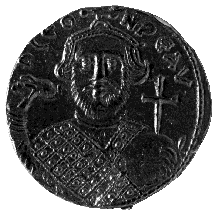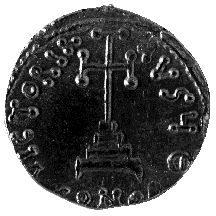



(138) Leontius - AV solidus, A.D. 695-698, 4.45 g. (inv. 91.278).
Obverse: Facing bust of Leontius, wearing loros and crown and holding
akakia in r. and globus cruciger in l.; D(OMINVS) LEON(TIVS)
PE(RPETVVS) AV(GVSTVS): Lord Leontius, perpetual Augustus.
Reverse: Cross potent on steps; VICTORIA AVGV(STI) ![]() : Victory of the Augustus,
officina mark
: Victory of the Augustus,
officina mark ![]() ; in exergue, CONOB: gold of Constantinople.
; in exergue, CONOB: gold of Constantinople.
Provenance: Coin Galleries, 1959.
Bibliography: P. Grierson, Byzantine Coins (London 1982).
Leontius usurped the throne from Justinian II in A.D. 695. He was unable
to put down Arab attacks on Carthage in northern Africa, however, and he
was deposed three years later. Although his reign introduced a long period
of instability, in which five emperors rose and fell in twenty years, his
coins are masterpieces of detail in the imperial dress.
On the obverse a robust, bearded Leontius wears the loros, an elaborately
jewelled and embroidered scarf wrapped around the body somewhat like a toga,
thrown first over the left shoulder, then pulled under the left arm, brought
across the front of the body, thrown over the right shoulder and pulled
across the back to the left hip, pulled across the front of the body again,
and then draped over the right arm (see no. 144). In his right hand he holds
an akakia, a symbol first adopted by Leontius and used in many imperial
portraits afterwards. It was a short cylinder with jewelled ends containing
dust, intended to remind the emperor that even he was mortal.
On the reverse, Leontius reverts to the cross potent on steps that was introduced
by the coins of Tiberius Constantine as a reference to the cross on the
hill of Calvary (see no. 133).
R.K.B.



All contents copyright (c) 1996.
Lawrence University
All rights reserved.